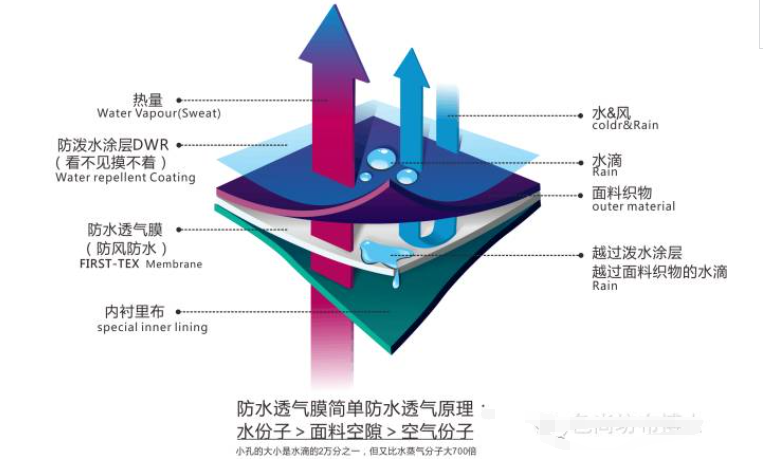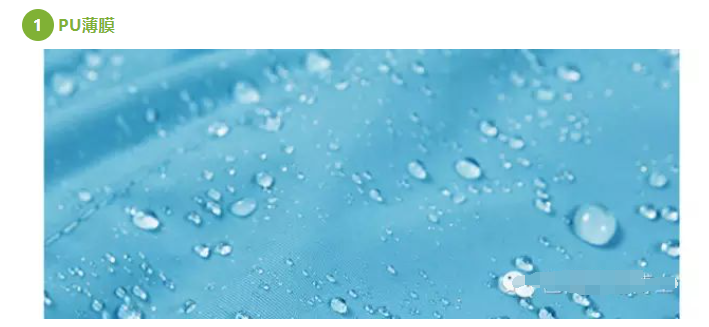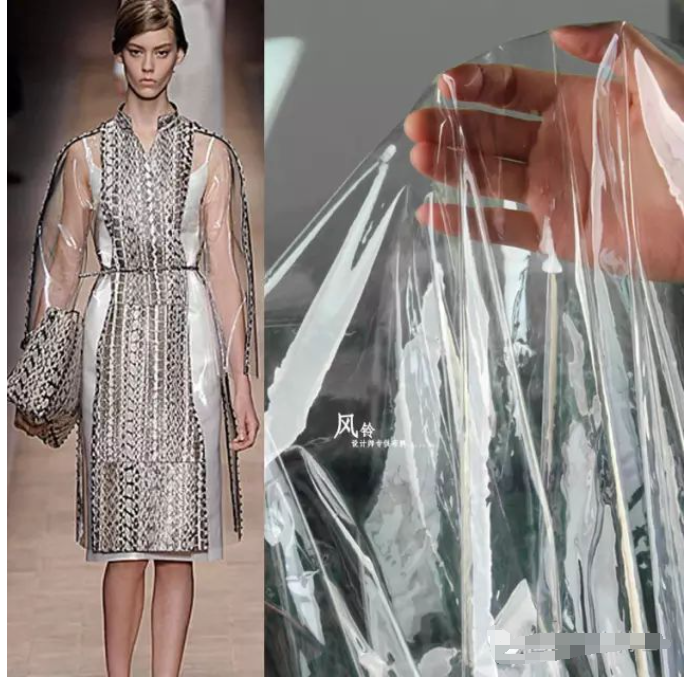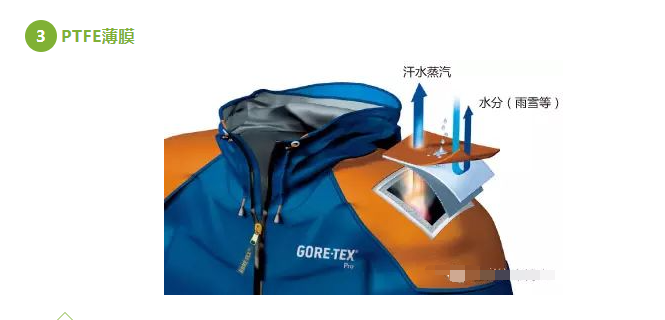Waterproof breathable fabric means that water cannot penetrate into the fabric under a certain pressure, and the sweat emitted by the human body can be transmitted to the outside world in the form of water vapor through the fabric, thereby preventing sweat from accumulating and condensing in the fabric. Between the body surface and the fabric to maintain wearing comfort, it is a high-tech, unique functional fabric.
Working principle
Waterproof and breathable
In the state of water vapor, water particles are very small. According to the principle of capillary movement, they can smoothly penetrate into the other side of the capillary tube. side, causing vapor permeability to occur. When water vapor condenses into water droplets, the particles become larger. Due to the surface tension of the water droplets (the water molecules “pull and compete” with each other), the water molecules cannot smoothly break away from the water droplets and penetrate to the other side, which prevents Water penetration occurs, making the breathable membrane waterproof.

Waterproofing is not a difficulty for the fabric industry. The key is how to achieve both breathability and realization. Super windproof. Below, we will give an in-depth explanation of new high-tech products from the perspective of waterproof, windproof and breathable fabric types.
Achieved by lamination (also called lamination) waterproof and breathable membrane

This is a material with good water pressure resistance. By combining the product fabric with it, it can achieve better waterproof stability. Its high-end products may have some moisture permeability. But the effect is far from ideal.

TPU is the abbreviation of thermoplastic polyurethane film, which is a non-porous hydrophilic film. Since the film itself has no pores, the waterproof effect is naturally very good. Breathability is mainly achieved through its hydrophilic characteristics. Depending on the difference in steam pressure inside and outside the clothes, steam is transferred from places with high pressure to places with low pressure, thereby achieving the breathable function.

PTFE (polytetrafluoroethylene) film is a new generation Waterproof and breathable material, currently used by world-class manufacturers.
The diameter of water vapor molecules is 0.0004 microns, the diameter of small mist in rainwater is 20 microns, and the diameter of drizzle is as high as 400 microns. If a film with a pore diameter between water vapor and rainwater can be made, , it can be both waterproof and breathable. The American Gore Company became the first company to produce this film using polytetrafluoroethylene (PTFE). It was laminated with fabric and then named GORE-TEX (Gore-TEX™) film. After continuous efforts, it is laminated with other hydrophilic films to form a composite film, and special treatment is performed on the film to greatly improve its fastness. It is generally believed that the water pressure of this fabric can reach 10,000mm, and the water pressure will drop significantly after washing 6-7 times; the air permeability can reach 10,000g/sqm*24hrs, but it is not possible to reach this value just after it is made. After several washings, part of the glue is washed away, and the available pores are increased and the air permeability is increased. At the same time, the clothing made of this fabric can also block the intrusion of cold wind and prevent the wind from taking away the heat emitted by the body through the fabric, making the body slimmer. No windchill due to heat loss; in addition, the fabric can resist 97.5% of ultraviolet rays.
Breathability through coating
Use dry direct coating, transfer coating, foam coating, phase inversion or wet coating (set coating) Through other technological techniques, various coating agents with waterproof and breathable functions are applied to the surface of the fabric, so that the surface gaps of the fabric are closed or reduced to a certain extent by the coating agent, thereby obtaining waterproof properties.
The breathability of the fabric is through the microporous structure formed by a special method on the coating or the interaction between the hydrophilic groups in the coating agent and water molecules. With the help of hydrogen bonds and other intermolecular forces, the air permeability can be improved in high humidity. One side absorbs water molecules and then passes them to the lower temperature side for analysis. Coated fabrics are low in price, achieve a certain degree of breathability, and are widely used. However, due to its poor waterproof and breathable performance and unsatisfactory feel, its market share is gradually decreasing.
Wet transfer coated fabrics bring new life to coated fabrics. Not only do they have high physical properties such as waterproofing and breathability, but the fabric can be treated with 100% Teflon, and its wash fastness can reach more than 25 times. It feels very good in hand.
Breathability through fiber was designed by the Shirley Research Institute in the UK in the 1940s. High-count, low-twist pure cotton yarn from Egyptian long-staple cotton was used as a high-density, heavy-weight flat weave fabric. Cold and immersion-resistant clothing for British Air Force pilots during World War I. When the fabric is dry, the gaps between the warp and weft yarns are large, about 10 microns, which can provide a highly breathable structure; when rain or water hits the fabric, the cotton yarns expand, reducing the gaps between the yarns to 3 to 4 microns.m, this closed-cell mechanism is combined with a special water-repellent finish to ensure that the fabric is not further penetrated by rainwater. At present, this type of fabric has long been replaced by other waterproof and breathable fabrics.
Sweat can be discharged from the body by creating holes inside the fiber, which is the moisture-absorbent and sweat-wicking fabric currently on the market.
The difference between water-repellent and waterproof
Waterproof, English water proof/water resistant, abbreviated as W/P, generally refers to making a rubber base on the bottom of the fabric, which is divided into coating and layer There are two types of lamination, which is truly waterproof.
Water repellent, also called water repellent, English water repellent, abbreviated as W/R, usually applies a layer of coating on the surface of the fabric to prevent water droplets from penetrating into the fabric easily. Generally Water droplets will form on the cloth (like lotus leaves). But it is not really waterproof, water will still seep inside if it stays for a long time. Fabrics treated with W/R will fail due to washing and long-term use. Even Gore-Tex W/R is only more durable than ordinary W/R.
In short, “waterproof” is more durable than “water-repellent” and has more stable physical and chemical properties. “Waterproof” products usually will not fail due to washing and long-term use; “waterproof” is more durable than “water-repellent” “Water repellent” has a higher water pressure resistance index, usually at least above 3000MM. Applied to clothing designers, the main function of anti-water repellent treatment is to reduce the adsorption of water to the fabric, so that it can be “pushed away” on the surface of the fabric. A waterproof treatment is a completely impermeable barrier that keeps water out regardless of whether the fabric is absorbent or not.






